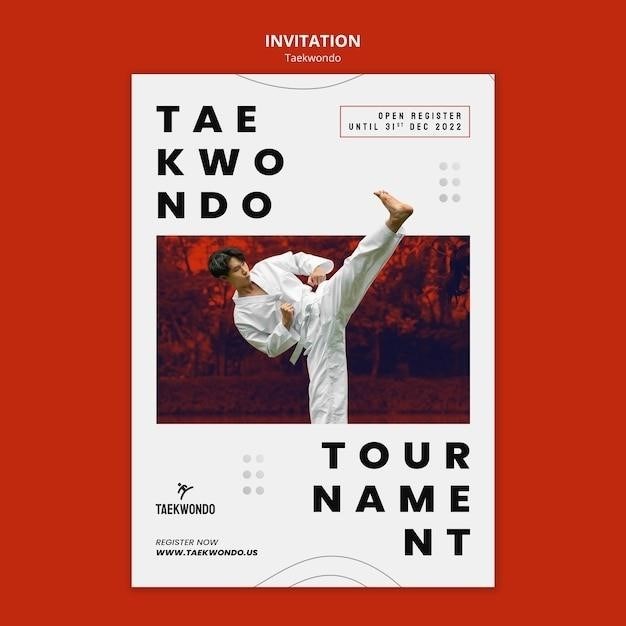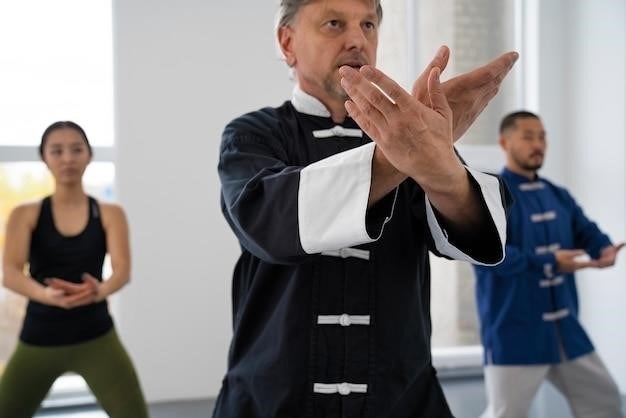Jeet Kune Do Book PDF⁚ A Comprehensive Guide
This comprehensive guide explores the world of Jeet Kune Do, Bruce Lee’s revolutionary martial art, through the lens of readily available PDF books. We’ll delve into its history, philosophy, techniques, and legacy, providing insights into the art’s essence and its enduring impact on modern martial arts.
Introduction
In the realm of martial arts, Jeet Kune Do stands as a unique and influential system, renowned for its emphasis on adaptability, fluidity, and personal expression. This guide aims to provide a comprehensive exploration of Jeet Kune Do, specifically focusing on the wealth of knowledge available in PDF book format. The world of Jeet Kune Do is vast, encompassing its historical roots, philosophical foundations, practical techniques, and enduring impact on the martial arts landscape. These PDF resources offer a valuable gateway for enthusiasts, practitioners, and curious minds to delve deeper into this multifaceted martial art.
The availability of Jeet Kune Do books in PDF format has democratized access to this knowledge, making it readily accessible to a global audience. Whether you’re a seasoned martial artist seeking to expand your understanding or a newcomer eager to learn about this captivating art form, the resources outlined in this guide can serve as a valuable starting point. From foundational principles to advanced strategies, these PDFs provide a wealth of information, allowing you to explore Jeet Kune Do at your own pace and convenience.
Bruce Lee’s Legacy⁚ The Tao of Jeet Kune Do
Jeet Kune Do is inextricably linked to the life and teachings of Bruce Lee, the martial arts icon who revolutionized the way we think about combat. His book, “Tao of Jeet Kune Do,” stands as a seminal work, offering a profound glimpse into his philosophy and the principles that guided his martial arts journey. This book, often available in PDF format, serves as a cornerstone for understanding the essence of Jeet Kune Do, highlighting its emphasis on personal expression, adaptability, and the pursuit of continuous improvement. Lee’s writings delve into the interconnectedness of physical and mental training, encouraging practitioners to develop their own unique style rather than adhering to rigid techniques.
The “Tao of Jeet Kune Do” transcends the limitations of a traditional martial arts manual, encompassing philosophical insights, practical guidance, and Lee’s personal reflections on his martial arts journey. It explores the concept of “being like water,” emphasizing the importance of fluidity, adaptability, and the ability to flow with the ebb and flow of combat. This book, through its accessible PDF format, allows readers to engage with Bruce Lee’s legacy, gaining insights into his revolutionary approach to martial arts and his enduring influence on the world of combat.
The Essence of Jeet Kune Do

Jeet Kune Do, often referred to as “the way of the intercepting fist,” is not merely a style of martial arts but a philosophy of combat and self-discovery. At its core, it emphasizes the rejection of rigid styles and the embrace of individuality. Jeet Kune Do practitioners are encouraged to develop their own unique approach, drawing upon various martial arts influences and adapting their techniques to the demands of each situation. This philosophy is embodied in Bruce Lee’s famous quote, “Be like water,” urging practitioners to be fluid, adaptable, and responsive like water, constantly adapting to their surroundings and opponents.
A key aspect of Jeet Kune Do is the concept of “no way as the way,” which emphasizes the pursuit of continuous self-improvement and the rejection of stagnation. Jeet Kune Do practitioners are encouraged to constantly analyze their techniques, identify weaknesses, and evolve their approach to combat. This philosophy of continuous learning and adaptation is reflected in the availability of numerous Jeet Kune Do books in PDF format, providing resources for practitioners to deepen their understanding of the art and explore its diverse applications.
Key Concepts and Principles
Jeet Kune Do is built upon a foundation of core concepts and principles that guide its practitioners. One of the most fundamental principles is “intercepting,” which emphasizes striking an opponent before they have a chance to launch their attack. This principle requires practitioners to be constantly aware of their surroundings and anticipate their opponent’s movements, allowing them to strike first and control the flow of the fight. Jeet Kune Do also emphasizes the importance of “non-linearity,” promoting the use of unpredictable movements and techniques to disrupt an opponent’s expectations and create opportunities for attack.
Another crucial principle is “simplicity,” which stresses the use of efficient and direct techniques. Jeet Kune Do practitioners are encouraged to focus on maximizing the effectiveness of their movements rather than relying on complex and intricate techniques. This principle is reflected in the art’s emphasis on practicality and its focus on achieving results with minimal effort. These key concepts and principles, often explored in depth in Jeet Kune Do books, provide a framework for practitioners to develop their understanding of the art and guide their training;

Techniques and Strategies
Jeet Kune Do techniques and strategies are characterized by their fluidity, adaptability, and emphasis on practicality. The art does not adhere to rigid forms or pre-determined movements, instead encouraging practitioners to develop their own unique style based on their strengths and weaknesses. Jeet Kune Do embraces a wide range of techniques drawn from various martial arts, including boxing, kung fu, and fencing, incorporating them into a fluid and dynamic fighting system. This eclectic approach allows practitioners to adapt their fighting style to different situations and opponents, making Jeet Kune Do a highly versatile and effective martial art.
Jeet Kune Do emphasizes the use of “stop hits,” which involve striking an opponent’s attack before it can be fully delivered. This technique requires practitioners to be highly reactive and able to anticipate their opponent’s movements. Other key techniques include “trapping,” which involves controlling an opponent’s limbs to prevent them from attacking, and “chain punching,” which involves striking an opponent with a series of rapid punches to overwhelm their defenses. These techniques, often detailed in Jeet Kune Do books, demonstrate the art’s focus on practicality, efficiency, and adaptability in combat.
Training and Practice
Training in Jeet Kune Do involves a multifaceted approach that emphasizes both physical and mental development. Jeet Kune Do practitioners engage in a rigorous training regimen that includes a variety of exercises designed to enhance strength, speed, flexibility, and coordination. These exercises may include shadowboxing, pad work, sparring, and drills that focus on specific techniques. Jeet Kune Do training also emphasizes the importance of developing mental discipline and focus, as practitioners are encouraged to cultivate a calm and alert state of mind, allowing them to react effectively under pressure.
The training process in Jeet Kune Do is highly individualized, as practitioners are encouraged to develop their own unique style based on their strengths and weaknesses. This personalized approach is reflected in the variety of training methods and materials available, including books, videos, and online resources. These resources provide practitioners with insights into the art’s philosophy, techniques, and strategies, offering guidance on developing their skills and understanding the principles of Jeet Kune Do. By embracing this individualized approach to training, Jeet Kune Do practitioners can develop their abilities in a way that aligns with their individual needs and goals.
Benefits of Jeet Kune Do
Jeet Kune Do offers a range of benefits that extend beyond physical prowess. Its core principles, emphasizing adaptability, self-expression, and continuous learning, contribute to personal growth and self-discovery. By embracing the fluidity and spontaneity inherent in Jeet Kune Do, practitioners can cultivate a sense of confidence and self-assurance, empowering them to navigate challenges both on and off the mat. The art’s emphasis on personal development encourages individuals to embrace their unique strengths and weaknesses, fostering a sense of self-awareness and self-acceptance.
Beyond its impact on self-development, Jeet Kune Do can also enhance physical fitness and well-being. The rigorous training regimen involves a wide array of exercises that target different muscle groups, improving strength, flexibility, and cardiovascular health. By engaging in regular Jeet Kune Do training, practitioners can experience increased energy levels, improved coordination, and a heightened sense of physical awareness. Furthermore, the art’s emphasis on self-defense provides a practical and effective way to protect oneself in potentially dangerous situations, fostering a sense of safety and security.
Famous Jeet Kune Do Practitioners
Beyond Bruce Lee, a constellation of martial artists have carried the torch of Jeet Kune Do, each contributing their unique perspectives and interpretations to its evolution. Among them is Dan Inosanto, a close friend and student of Bruce Lee, who has been instrumental in disseminating the art’s principles and techniques to a wider audience. His extensive knowledge and dedication have made him a leading figure in the Jeet Kune Do community, his teachings influencing countless practitioners worldwide. Other notable figures include Taky Kimura, a student who trained with Bruce Lee for over a decade and later developed his own style known as “Jun Fan Gung Fu,” incorporating elements of Jeet Kune Do. His emphasis on practicality and efficiency has made him a respected figure in the martial arts world.
The legacy of Jeet Kune Do extends beyond the martial arts realm, inspiring individuals in diverse fields to embrace its principles of adaptability, self-expression, and continuous learning. From renowned actors like Chuck Norris and Jackie Chan to accomplished martial artists like Shannon Lee, Bruce Lee’s daughter, who continues to promote her father’s legacy, the influence of Jeet Kune Do is evident in the lives of many individuals who have been inspired by its philosophy and techniques. By exploring the stories and contributions of these prominent figures, readers can gain a deeper appreciation for the art’s evolution and its enduring impact on the world of martial arts.
Jeet Kune Do in Modern Martial Arts
Jeet Kune Do’s influence on modern martial arts is undeniable. Its core principles of adaptability, self-expression, and continuous improvement have resonated with martial artists across various disciplines, prompting them to re-evaluate traditional approaches and embrace a more fluid and dynamic style of combat. The art’s emphasis on practicality and efficiency has inspired practitioners to develop their own unique methods, drawing upon diverse fighting systems to create personalized styles that best suit their individual strengths and weaknesses. This focus on personal development and self-discovery has led to a resurgence of interest in martial arts as a means of personal growth and self-expression, fostering a more inclusive and dynamic approach to martial arts training.
The legacy of Jeet Kune Do has also fostered a greater appreciation for cross-training and the integration of diverse martial arts techniques. Modern martial arts practitioners are increasingly open to incorporating elements from different disciplines, such as boxing, kickboxing, Muay Thai, and Brazilian Jiu-Jitsu, into their training regimens. This eclectic approach has led to the development of hybrid martial arts styles that combine the best aspects of various fighting systems, creating a more comprehensive and effective form of combat. The influence of Jeet Kune Do’s philosophy has paved the way for a more dynamic and innovative approach to martial arts training, inspiring practitioners to think outside the box and explore new avenues for personal and martial development.
Jeet Kune Do Books⁚ A Valuable Resource
Jeet Kune Do books offer a valuable resource for martial arts enthusiasts seeking to deepen their understanding of Bruce Lee’s philosophy and techniques. These books serve as a gateway to the art’s core principles, providing insights into its practical applications and its profound impact on the evolution of modern martial arts. From detailed explanations of fundamental techniques to explorations of the art’s philosophical underpinnings, these publications offer a comprehensive guide to Jeet Kune Do, allowing practitioners to delve into the art’s complexities and nuances. Whether you’re a beginner seeking to learn the basics or an experienced martial artist seeking to refine your skills, Jeet Kune Do books provide a wealth of knowledge and inspiration.
Beyond technical instruction, Jeet Kune Do books delve into the art’s unique approach to self-discovery and personal development. They explore Bruce Lee’s concept of “being like water,” emphasizing the importance of adaptability, fluidity, and continuous self-improvement. These books encourage readers to embrace a holistic approach to martial arts, fostering a connection between mind, body, and spirit. Whether you’re seeking to enhance your physical skills, cultivate a deeper understanding of yourself, or simply explore the fascinating world of martial arts, Jeet Kune Do books offer a valuable resource for personal growth and martial enlightenment.
Where to Find Jeet Kune Do Books in PDF Format
Finding Jeet Kune Do books in PDF format is easier than you might think. The internet offers a vast library of resources, with various websites and platforms dedicated to sharing knowledge and literature on martial arts. One popular avenue is online bookstores, where you can often find free downloads of classic Jeet Kune Do texts like “Tao of Jeet Kune Do” by Bruce Lee. These digital versions are often accessible for personal use, allowing you to study the art’s principles and techniques at your convenience.
Additionally, many martial arts forums and communities online host discussions and resources, including PDF versions of Jeet Kune Do books. These platforms often feature active discussions among practitioners, providing valuable insights and perspectives on the art’s teachings. Furthermore, dedicated websites and blogs specializing in martial arts literature often offer free or paid downloads of Jeet Kune Do books in PDF format. These platforms are curated specifically for martial arts enthusiasts, ensuring the quality and authenticity of the content. By exploring these online resources, you can readily access a wealth of information on Jeet Kune Do, expanding your knowledge and deepening your understanding of this fascinating martial art.
Tips for Choosing the Right Book
With a plethora of Jeet Kune Do books available in PDF format, selecting the right one for your needs can be a daunting task. Here are some key tips to guide your selection⁚
Firstly, consider your experience level. Beginner-friendly books, like “Jeet Kune Do Basics” by David Cheng, provide a solid foundation in the art’s fundamental principles. If you’re more experienced, advanced texts such as “The Tao of Jeet Kune Do” by Bruce Lee offer deeper insights and philosophical explorations; Secondly, examine the author’s credentials. Books authored by renowned practitioners or experts in Jeet Kune Do, like Bruce Lee himself, carry greater credibility and authority. Thirdly, read reviews and testimonials to gauge the book’s quality and relevance. Online forums and martial arts communities are excellent resources for gathering feedback from fellow practitioners.
Finally, consider your learning style and preferences. Some books emphasize theoretical concepts, while others focus on practical techniques. Choose a book that aligns with your learning style and interests, ensuring a more engaging and rewarding experience. By carefully considering these factors, you can select a Jeet Kune Do book in PDF format that perfectly suits your needs and helps you embark on a fulfilling journey of martial arts exploration.
